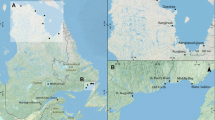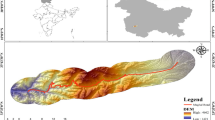Abstract
Snow avalanches represent an undeniable reality in the Southern Carpathians both as a geomorphic process and as a type of hazard. Before the 1990s, few researchers focused on avalanches in Romania. However, after 1990, avalanches became an increasingly important topic of Romanian research including research on their management implications. This study focuses on the Făgăraş massif, a representative mountain unit in the Southern Carpathians that is dominant due to its glacial and periglacial relief, high altitudes and high occurrence of avalanche hazards. Three main research issues are considered. First, types of avalanches are delineated along with affected areas of the Bâlea glacial valley (on the northern slope) and the Capra glacial valley (on the southern slope) using data from a research centre for snow and avalanche monitoring that was created in the Bâlea glacial cirque in 2003. Second, the impact of avalanches on human activities is considered including transportation use of the Transfăgărăşan Highway that traverses the highest elevations in Romania and winter recreation activities such as skiing, snowboarding, climbing and hiking. The impacts on forests are also considered. Third, the needs and gaps of avalanche management are considered, specifically in the Făgăraş massif and also more generally in the mountains of Romania.













Similar content being viewed by others
References
Administraţia Naţională de Meteorologie (2003–2004) Bilanţul nivologic, sezonul de iarnă, Laboratorul de prelucrare a datelor meteorologice, Colectivul de Nivometeorologie, Ministerul Mediului şi Gospodăririi Apelor Bucureşti, 76 pp
Administraţia Naţională de Meteorologie (2004–2005) Bilanţul nivologic, sezonul nivologic, Secţia de Meteorologie Dinamică, Climatologie şi Agrometeorlogie, Grupul de Verificare a Prognozelor şi Adaptare Statistică (GVPAS), Ministerul Mediului şi Gospodăririi Apelor, Bucureşti, 147 pp
Administraţia Naţională de Meteorologie (2005–2006) Bilanţul nivologic, sezonul nivologic, Secţia de Meteorologie Dinamică, Climatologie şi Agrometeorlogie, Grupul de Verificare a Prognozelor şi Adaptare Statistică, Colectivul de Nivometeorlogie, Ministerul Mediului şi Gospodăririi Apelor, Bucureşti, 132 pp
Agrawala S (dir) (2007) Changements climatiques dans les Alps Européennes. Adapter le tourisme d’hiver et la gestion des risques naturels, OCDE, 140 pp
Ammann W (2003) Integral risk management in avalanche prevention and mitigation: the Swiss approach. In: Hervás J (ed) Recommendations to deal with snow avalanche in Europe. Nedies Project, European Commission, Joint Research Centre, pp 27–38
Ancey C (1998) Guide, neige et avalanche. Connaissances, Practiques & Sécurité, 3èmeédition. École Polytechnique Fédérale de Lausanne, 281 pp
Ancey C (2001) Snow avalanches. In: Balmforth N, Provenzalle A (eds) Geomorphological fluid mechanics: selected topics in geological and geomorphological fluid mechanics. Springer, Berlin, pp 319–338
Ancey C (dir) (2005) Gestion et prévision du risque d’avalanches. In: Dynamiques des avalanches. Cemagref, Presses Polytehniques et Universitaires Romandes, pp 133–160
Ancey C, Charlier C (1996) Quelques réflexions autour d’ une classification des avalanches. Rev Geogr Alp 84(1):9–21
Armstrong BR, Williams K, Armstrong RL (1994) The avalanche book, rev & updated edition. Fulcrum Publishing, 240 pp
Beniston M, Keller F, Goyette S (2003) Snow pack in the Swiss Alps under changing climatic conditions: an empirical approach for climate impacts studies. Theor Appl Climatol 74:19–31
Besançenot JP (1990) Climat et tourism. MASSON, Collection Géographie, Paris, 223 pp
Bezzi M, Cantiani MGM, Ciolli M, Comunello G, Cherubini P (2002) Leggere gli anelli degli alberi per riconstruire la frequenza e l’estensione delle valanghe nel passato, S.I.S.E.F. Atti 3:147–152
Breiling M, Charamza P (1999) The impact of global warming on winter tourism and skiing: a regionalised model for Austrian snow conditions. Reg Environ Chang 1(1):4–14. doi:10.1007/s101130050003
Capello CF (1973) Il problema delle valanghe. Boll Soc Geogr Ital, Monto nevoso e morfologia, Suppl., II(10):265–296
Ciolli M, Tabarelli S, Zatelli P (1998) 3D spatial data integration for avalanche risk management, IAPRS. GIS-Between Vis Appl Stuttg 32(Part 4):121–127
Civil Protection Command (2004) National report regarding disaster prevention in Romania. Ministry of Administration and Interior, Bucharest, 38 pp
Dorren L, Berger F, Imeson A, Maier B, Rey F (2004) Integrity, stability and management of protection forests in the European Alps. For Ecol Manag 195(1–2):165–176
Embleton C (1979) Nival processes. In: Process in geomorphology. Edward Arnold, London, pp 307–324
Embleton C, King CAM (1974) Periglacial geomorphology. Arnold, London, 215 pp
Fleischhauer M, Greiving S, Schlusemann B, Schmidt-Thomé P, Kallio H, Tarvainen T et al (2005) Multi-risk assessment of spatially relevant hazards in Europe, ESPON, ESMG symposium, Nürnberg, 14 pp
Fuchs S, Bründl M (2005) Damage potential and losses resulting from snow avalanche in settlements of the canton of Grisons, Switzerland. Nat Hazards 34:53–69. doi:10.1007/s11069-004-0784-y
Gardner J (1970) Geomorphic significance of avalanches in the Lake Louise Area, Alberta, Canada. Arct Alp Res 2(2):135–144. doi:10.2307/1550348
Germain D, Filion L, Hétu B (2005) Snow avalanche activity after fire and logging disturbance, northern Gaspé Peninsula, Quebec, Canada. Can J Earth Sci 42:2103–2116. doi:10.1139/e05-087
Gumuchian H (1990) La neige dans les Alpes françaises du Nord, Editions des Cahiers de l’Alpe de la Société des Écrivains Dauphinois, Grenoble, 617 pp
Gürer I (1998) International cooperation for solving the avalanche problem in Turkey. Nat Hazards 18:77–85. doi:10.1023/A:1008013710228
Höller P (2007) Avalanche hazards and mitigation in Austria: a review. Nat Hazards 43:81–101. doi:10.1007/s11069-007-9109-2
International Symposium on Scientific aspects of Snow and Ice Avalanches (1966) Reports and discussions, International Union of Geodesy and Geophysics, International Association of Scientific Hydrology, Publication No. 69 de l’AIHS, 5–10 April 1965, Davos, 432 pp
Jaccard C (1990) Fuzzy factorial analysis of snow avalanches. Nat Hazards 3:329–340. doi:10.1007/BF00124391
Jamieson B, Stethem C (2002) Snow avalanche hazards and management in Canada: challenges and progress. Nat Hazards 26:35–53. doi:10.1023/A:1015212626232
Johnson EA (1987) The relative importance of snow avalanche disturbance and thinning on canopy plant population. Ecology 68:43–53. doi:10.2307/1938803
Keiler M, Sailer R, Jörg P, Weber C, Fuchs S, Zischg A et al (2006) Avalanche risk assessment—a multi-temporal approach, results from Galtür, Austria. Nat Hazards Earth Syst Sci 6:637–651
Kulakowski D, Rixen C, Bebi P (2006) Changes in forest structure and in the relative importance of climatic stress as a result of suppression of avalanche disturbances. For Ecol Manag 223(1–3):66–74
Kuroda M (1967) Classification of snow avalanches. In: Physics of snow and ice: proceedings. Institute of Low Temperature Science, Hokkaido Univ, vol 1(part 2), pp 1277–1290
Larocque S, Hétu B, Filion L (2001) Geomorphic and dendroecological impacts of slushflow in central Gaspé Peninsula (Québec, Canada). Geogr Ann 83A:191–201. doi:10.1111/1468-0459.00154
Luckman BH (1977) The geomorphic activity of snow avalanches. Geogr Ann 59A(1–2):31–48
Margreth S, Stoffel L, Wilhelm C (2003) Winter opening of high alpine pass roads—analysis and case studies from the Swiss Alps. Cold Reg Sci Technol 37(3):467–482
McClung DM (2000) Extreme avalanche runout in space and time. Can Geotech J 37:161–170
McClung DM, Schaerer P (1993) The avalanche handbook, the mountaineers. Seattle, 271 pp
Mock C (1996) Avalanche climatology of Alyeska, Alaska, U.S.A. Arct Alp Res 28(4):502–508. doi:10.2307/1551861
O’Gorman D (Project Leader) (2003) Report of the independent panel. Prepared for Parks Canada, 30 June, 90 pp
Quinn MS, Phillips J (2000) Avalanche paths in TFL14: inventory, description, classification and management. Final report to Crestbrook Forest Industries Inc., Faculty of Environmental Design, University of Calgary, 137 pp
Schaerer P (1989) The avalanche-hazard index. Ann Glaciol 13:241–247
Schmidt-Thomé P (ed) (2006) The spatial effects and management of natural and technological hazards in Europe—ESPON 1.3.1. Executive summary, 309 pp
Schönenberger W, Noack A, Thee P (2005) Effect of timber removal from windthrow slopes on the risk of snow avalanches and rockfall. For Ecol Manag 213(1–3):197–208
Schweizer J, Camponovo C (2001) The skier’s zone of influence in triggering slab avalanches. Ann Glaciol 32(1(7)):314–320
Schweizer J, Jamieson B (2001) Snow cover properties for skier triggering of avalanches. Cold Reg Sci Technol 33(2–3):207–221
Schweizer J, Lütschg M (2001) Characteristics of human-triggered avalanches. Cold Reg Sci Technol 33(2–3):147–162
Smith MJ (1993) Frequency and terrain factors for high-frequency snow avalanche paths. A thesis submitted in partial fulfillment of the requirements for the degree of Master of Science in the Faculty of Graduate Studies, Department of Geography, The University of British Columbia, 58 pp
Smith MJ, McClung DM (1997) Avalanche frequency and terrain characteristics at Roger’s Pass, British Columbia, Canada. J Glaciol 43(143):165–171
Stethem C, Jamieson B, Liverman D, Germain D, Walker S (2003) Snow avalanche hazard in Canada—a review. Nat Hazards 28:487–515. doi:10.1023/A:1022998512227
UNESCO (1981) Avalanche atlas. Illustrated international avalanche classification. International Commission of Snow and Ice of the International Association of Hydrological Sciences, Switzerland, 265 pp
van Herwijnen A, Jamieson B (2007) Snowpack properties associated with fracture initiation and propagation resulting in skier-triggered dry snow slab avalanches. Cold Reg Sci Technol 50(1–3):13–22
Vanni M (1965) Pour une classification géographique des avalanches. In: International symposium on scientific aspects of snow and ice avalanches. Report and discussions. Davos, pp 397–407
Voiculescu M (2002a) Studiul potenţialului geoecologic al Masivului Făgăraş şi protecţia mediului înconjurător, Editura Mirton, Timişoara, 375 pp
Voiculescu M (2002b) Fenomene geografice de risc in Masivul Făgăraş, Editura Mirton, Timişoara, 231 pp
Voiculescu M (2004a) Întocmirea hărţii riscului la avalanşe. Studiu de caz: circul şi valea glaciară Bâlea (Masivul Făgăraş), Riscuri şi catastrofe, Nr. 1, Casa Cărţii de Ştiinţă, Cluj-Napoca, pp 243–251
Voiculescu M (2004b) About the morphometrical characteristics of avalanche tracks on Bâlea–Capra Area (Făgăraş massif); Analele Universităţii de Vest din Timişoara. Ser Geogr XIV:31–43
Voiculescu M (2004c) Types of avalanches and their morphogenetical impact in Făgăraş Masiff—Southern Carpathians (Romania), Geomorphologia Slovaca, Číslo 1, ročník 4, Bratislava, pp 72–81
Voiculescu M, Flueraru C (2008) Mapping avalanche hazard. Case study: Capra Valley, Făgăraş Mountains, Romanian. J Meteorol (in press)
Weir P (2002) Snow avalanche management in forested terrain, British Columbia. Ministry of Forests, Forest Science Program, 190 pp
Weiss G (2000) Evaluation of policy instruments for protective forest management in Austria. For Policy Econ 1(3–4):243–255
Zeidler A (2004) Forecasting shier-triggered avalanches in the Columbia Mountains of Canada. A thesis submitted to the Faculty of Graduate Studies in partial fulfillment of the requirements for the degree of Doctor of Philosophy, Department of Engineering, Calgary, 270 pp
Acknowledgements
The author would like to express his appreciation to Maria Moţoiu, meteorologist, in charge of the nivometeorology research group of the Dynamic Meteorology Climatology and Agrometeorology Department, to the Group of Forecast Analysis and Statistic Adaptation, National Administration of Meteorology, to Narcisa Milian, forecast meteorologist at Regional Weather Forecast Centre, Sibiu for having made available documentation of the nivological balances for the winters of 2003–2004, 2004–2005 and 2005–2006, to Adi David, director of Mountain Rescuers Sibiu (on the northern slope), to Mountain Rescuers Victoria (on the northern slope) and to Mountain Rescuers Argeş (on the southern slope), for statistical data, regarding the fatalities in the Făgăraş massif.
Author information
Authors and Affiliations
Corresponding author
Rights and permissions
About this article
Cite this article
Voiculescu, M. Snow avalanche hazards in the Făgăraş massif (Southern Carpathians): Romanian Carpathians—Management and perspectives. Nat Hazards 51, 459–475 (2009). https://doi.org/10.1007/s11069-008-9281-z
Received:
Accepted:
Published:
Issue Date:
DOI: https://doi.org/10.1007/s11069-008-9281-z




